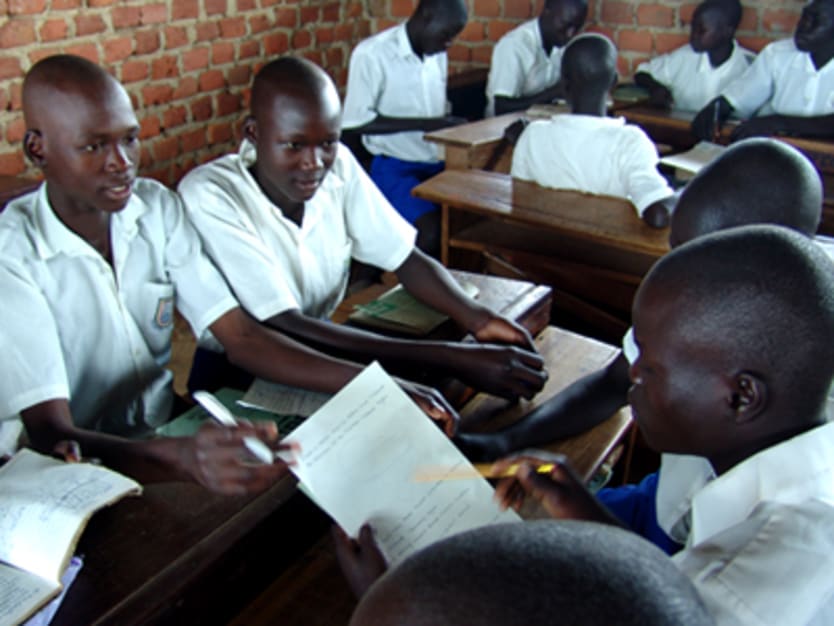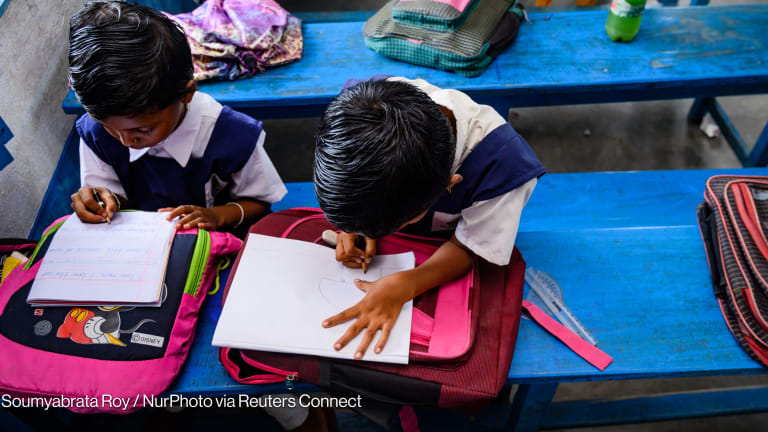
USAID initiatives and funding to kickstart education technology innovations have some experts wondering whether educators or technology advocates are driving U.S. international education policy.
But the U.S. Agency for International Development’s embrace of technology for education will not supplant traditional support for teacher professional development and other long-time education assistance priorities, according to an official.
This week Devex caught up with agency officials and industry experts on the sidelines of the 2013 USAID Education Summit, where education technology was one of the hot topics bringing together USAID staff from missions around the world and representatives from implementing partners in Washington, D.C.
The challenges facing global education are dire. In his keynote address to close the meeting, USAID Administrator Rajiv Shah reminded participants what they have been tasked to overcome: dismally low records of educational performance in crisis-afflicted countries, 57 million children out of school worldwide, and the fact that a child in Africa still has a 40 percent chance of being illiterate after five years of school.
These conditions have led the agency, explained Shah, to focus on areas where its resources can have the most impact — in particular, leveraging technology for development.
Still, some experts question whether the agency’s focus on innovation is contributing to a global education policy that emphasizes technology for technology’s sake, instead of for leadership, connection, and learning.
Technology can be ‘quick fix’
“The problem is if you see [technology] in isolation, you don’t see it as a servant of the value, it becomes the goal in itself,” Richard Rowe, CEO of Open Learning Exchange, Inc. told Devex.
Those concerns are amplified by a political climate where foreign aid budgets are perennially at risk and the U.S. Congress demands either quick and visible results or a national security argument to justify assistance spending.
“Politicians particularly want a quick fix, they want a silver bullet, and the manufacturers of technology like that idea too, because they have the silver bullet, or at least they’re selling the silver bullet,” said Rowe. “So there’s this kind of collusion between the politicians who want a quick fix and the technologists who are quite happy to claim a quick fix.
But a USAID official spearheading these efforts insisted that while the agency is scaling up platforms for research and development, private sector partnerships and funding competitions for science and technology entrepreneurs, these all serve to support —not replace — ongoing mission-led efforts to improve basic education.
“What we want to do is avoid, in the spirit of innovation, competing with or duplicating what might already be going on,” Tony Bloome, USAID senior education technology specialist, told Devex.
Reflecting on the education strategy
This year’s education summit provided an opportunity for reflection and renewed commitment halfway through USAID’s five-year education strategy, launched in 2011.
READ: Is USAID’s education strategy achieving real change?
Upcoming on the education agenda this fall is the second round of USAID’s “All Children Reading” Grand Challenge for Development — an ambitious funding competition targeting “breakthrough” advances in early-grade literacy. The Grand Challenge model, a key priority under Shah’s leadership, offers entrepreneurs and businesses an avenue to USAID funding for products and business plans the agency hopes can spark progress on elusive development goals such as early-grade reading.
The next challenge, unlike the first round, will focus exclusively on science and technology innovations for education, noted Bloome.
The narrowed focus, he explained, is meant to stake out a separate portfolio of education programming, apart from teacher professional development efforts that USAID country missions already support.
“We thought the value added of the grand challenge model … was that unique component of applying science and technology explorations and identifying traditional and nontraditional players,” said the official.
Apart from its exclusive focus on science and technology solutions, the second round of the challenge will also differ from the first by offering prizes in addition to grants. USAID received over 450 proposals during the first round of the challenge and selected 32 for funding. Bloome was unable to confirm how many proposals would be accepted in the second round competition.
The role of US foreign aid
Agency officials are optimistic about the role U.S. foreign assistance and partnerships can play in developing and distributing new technology to students and teachers around the world, particularly in places where geographic isolation, political instability, or ongoing conflict limit children’s access to reading materials and other educational resources.
That optimism is reflected in the agency’s education strategy, which places a heavy premium on leveraging technology development and distribution through partnerships with entrepreneurs, businesses and other donors and investors. The education strategy built on the initiation of Shah’s USAID Forward reform agenda, which elevates the role of science and technology at the agency to a core priority, along with procurement reform and better monitoring and evaluation.
“All Children Reading” is one piece of an effort to improve reading skills for 100 million children by 2015, but it is not the only piece that is focused on expanding use of educational technology.
The Mobiles for Education or “MEducation” Alliance convenes U.S. government agencies, international financial institutions, private foundations and trade associations like GSMA, which represents the interests of 800 mobile operators worldwide, and aims to promote the use of low-cost mobile technologies to overcome educational barriers in low-income countries.
That kind of technology promotion, in partnership with technology advocates, is what has some observers worried that mobile companies are more interested in tapping new markets — especially youth markets — than in achieving learning objectives.
But according to Bloome, private sector engagement represents a viable way to achieve scale, especially if USAID is going to make any progress in targeting out of school youth, who are otherwise difficult to reach. At the same time, he noted, if the private sector wants to build a productive relationship with the agency for the deployment of mobile education technologies, it will be incumbent on companies to invest more in evaluation.
Far from describing an assured silver bullet, the evidence for technology’s impact on improved learning provides a thin evidence base for increasing the role for technology in the U.S. international education portfolio. Both learning and technology are notoriously difficult to measure and predict, and the relationship between them is even more elusive. And to date, the evidence is mostly anecdotal.
For some experts, the evidence gap on improved learning is part of the justification for developing and distributing mobile educational technologies, and for bringing the private sector on board for better evaluations.
Even if the direct link between more technology and improved learning has not been fully established, they argue there is still a significant role for mobile technology to play in capturing data about learning outcomes, especially from remote areas, to help bolster that weak evidence base for education policy decision-making.
Read more on U.S. aid reform online, and subscribe to The Development Newswire to receive top international development headlines from the world’s leading donors, news sources and opinion leaders — emailed to you FREE every business day.








